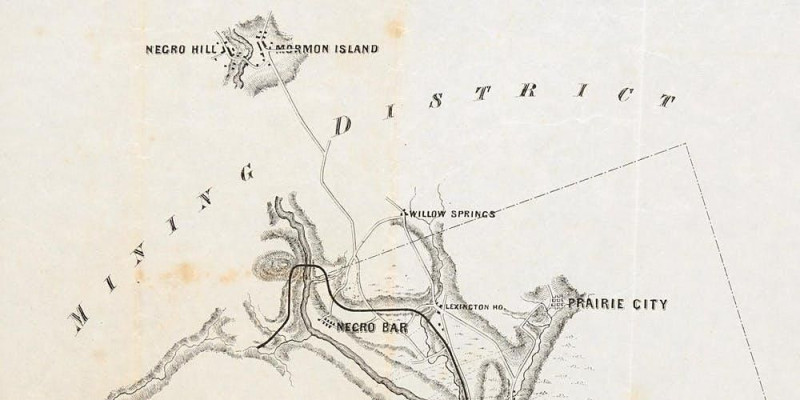From the Open-Publishing Calendar
From the Open-Publishing Newswire
Indybay Feature
2023 California Admission Day - City of Sacramento to Negro Bar, Sacramento County
In the early 16th-century romance novel entitled, Las Sergas de Esplandián (The Adventures of Esplandián), California was the name of a mythical island populated by Negro women warriors, led by Queen Califia. Beginning in January 1848, throughout the initial California Gold Mining District along the American River Basin, people of Pan African Ancestry remain key salient contributors to the forward flow of humanity.

On September 9, 1850, California officially became the 31st State of the United States of America, upsetting the delicate balance of 15 "free" states and 15 "slave" states.
From the City Sacramento to the Negro Hill, Mormon Island and Negro Bar Gold Mining District, the world's first "viral story" the California Gold Rush comes alive again during Summer 2023.
In the early 16th-century romance novel entitled, Las Sergas de Esplandián (The Adventures of Esplandián), California was the name of a mythical island populated by Negro women warriors, led by Queen Califia. Beginning in January 1848, throughout the initial California Gold Mining District along the American River Basin, people of Pan African Ancestry remain key salient contributors to the forward flow of humanity.
Honorable William Alexander Leidesdorff, Jr. acquired Rancho Rio De Los Americanos in 1844. His 35,521 acre Mexican Land Grant, uniquely stipulated that he would not disturb the migrations of Nisenan/Maidu nations upon land newly entitled to the man we affectionately call today, our "African Founding Father of California."
January 1848, gold was discovered upstream along the south fork of the American River in Coloma Valley. Throughout the Gold Mining District, prospecting for gold was a very difficult physical full-time occupation, usually driving most men mad and financially destitute.
The leading regional mining towns of Negro Hill, Mormon Island and Negro Bar were well established by fall of 1848. On September 9, 1850, California Admission Day, the gold mining town of Negro Bar, transportation hub for the regional gold mining district, offered a strategic location for regional economic development.
New York Railroad Engineer Theodore Judah created a survey map, dated September 1854 that was utilized to show the viability and strategic importance of the first Commerical Railroad in the West. Wall Street, NY financial markets invested in the construction of the Sacramento Valley Railroad, Inc, that terminated at the crossing of the American River at Negro Bar, Sacramento County.
September 9, 1850, is California Admission Day.
Everyone is invited to celebrate the officially birthday of our Great State of California and reflect upon authentic history of Historic Negro Bar, along today's Lake Natoma Waterfront, City of Folsom, California.
From the City Sacramento to the Negro Hill, Mormon Island and Negro Bar Gold Mining District, the world's first "viral story" the California Gold Rush comes alive again during Summer 2023.
In the early 16th-century romance novel entitled, Las Sergas de Esplandián (The Adventures of Esplandián), California was the name of a mythical island populated by Negro women warriors, led by Queen Califia. Beginning in January 1848, throughout the initial California Gold Mining District along the American River Basin, people of Pan African Ancestry remain key salient contributors to the forward flow of humanity.
Honorable William Alexander Leidesdorff, Jr. acquired Rancho Rio De Los Americanos in 1844. His 35,521 acre Mexican Land Grant, uniquely stipulated that he would not disturb the migrations of Nisenan/Maidu nations upon land newly entitled to the man we affectionately call today, our "African Founding Father of California."
January 1848, gold was discovered upstream along the south fork of the American River in Coloma Valley. Throughout the Gold Mining District, prospecting for gold was a very difficult physical full-time occupation, usually driving most men mad and financially destitute.
The leading regional mining towns of Negro Hill, Mormon Island and Negro Bar were well established by fall of 1848. On September 9, 1850, California Admission Day, the gold mining town of Negro Bar, transportation hub for the regional gold mining district, offered a strategic location for regional economic development.
New York Railroad Engineer Theodore Judah created a survey map, dated September 1854 that was utilized to show the viability and strategic importance of the first Commerical Railroad in the West. Wall Street, NY financial markets invested in the construction of the Sacramento Valley Railroad, Inc, that terminated at the crossing of the American River at Negro Bar, Sacramento County.
September 9, 1850, is California Admission Day.
Everyone is invited to celebrate the officially birthday of our Great State of California and reflect upon authentic history of Historic Negro Bar, along today's Lake Natoma Waterfront, City of Folsom, California.
Add Your Comments
We are 100% volunteer and depend on your participation to sustain our efforts!
Get Involved
If you'd like to help with maintaining or developing the website, contact us.
Publish
Publish your stories and upcoming events on Indybay.
Topics
More
Search Indybay's Archives
Advanced Search
►
▼
IMC Network


